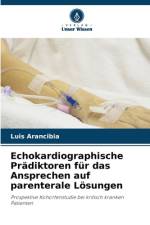von Luis Arancibia
39,90 €
Das Ansprechen auf parenterale Lösungen bei kritisch kranken Patienten wurde anhand von Indikatoren für die ventrikuläre Vorlast mittels Echokardiographie untersucht. Bei 36 Patienten, die als kritisch krank in ein Krankenhaus eingeliefert wurden, wurden vor der Volumenexpansion komorbide Anamnese, hämodynamische Parameter, Bluttestdaten und echokardiographische Messungen durchgeführt; Patienten, bei denen das systolische Volumen und das Herzzeitvolumen nach der Expansion um mehr als 15 % zunahmen, wurden als ansprechend eingestuft. Ringer-Laktat wurde als Expander verwendet. 25 % der Patienten sprachen nicht auf das Volumen an, bei ihnen war die Diabetesanamnese ein konditionierender Faktor unter den untersuchten Parametern, die wir analysiert haben; Das rechtsventrikuläre teildiastolische Volumen (VTDVD) und die linksventrikuläre teildiastolische Fläche (ATDVI) waren bei denjenigen, die auf das Volumen ansprachen, signifikant niedriger als bei denjenigen, die nicht darauf ansprachen; anhand der ROC-Kurve wurde festgestellt, dass, VTDVD hat eine Fläche unter der Kurve von 0,98 (P=0,01, 95% [CI] 0,95-1,00), ATDVI hat eine Fläche unter der Kurve von 0,96 (P=0,00, 95% [CI] 0,90-1,00), um das Nichtansprechen auf die Volumenexpansion mit parenteralen Lösungen vorherzusagen.






